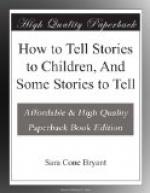The night came. When it was perfectly dark and still, Tarpeia stole from her bed, took the great key from its place, and silently unlocked the gate which protected the city. Outside, in the dark, stood the soldiers of the enemy, waiting. As she opened the gate, the long shadowy files pressed forward silently, and the Sabines entered the citadel.
As the first man came inside, Tarpeia stretched forth her hand for her price. The soldier lifted high his left arm. “Take thy reward!” he said, and as he spoke he hurled upon her that which he wore upon it. Down upon her head crashed—not the silver rings of the soldier, but the great brass shield he carried in battle!
She sank beneath it, to the ground.
“Take thy reward,” said the next; and his shield rang against the first.
“Thy reward,” said the next—and the next—and the next—and the next; every man wore his shield on his left arm.
So Tarpeia lay buried beneath the reward she had claimed, and the Sabines marched past her dead body, into the city she had betrayed.
THE BUCKWHEAT[1]
[Footnote 1: Adapted from Hans Christian Andersen.]
Down by the river were fields of barley and rye and golden oats. Wheat grew there, too, and the heaviest and richest ears bent lowest, in humility. Opposite the corn was a field of buckwheat, but the buckwheat never bent; it held its head proud and stiff on the stem.
The wise old willow-tree by the river looked down on the fields, and thought his thoughts.
One day a dreadful storm came. The field-flowers folded their leaves together, and bowed their heads. But the buckwheat stood straight and proud.
“Bend your head, as we do,” called the field-flowers.
“I have no need to,” said the buckwheat.
“Bend your head, as we do!” warned the golden wheat-ears; “the angel of the storm is coming; he will strike you down.”
“I will not bend my head,” said the buckwheat.
Then the old willow-tree spoke: “Close your flowers and bend your leaves. Do not look at the lightning when the cloud bursts. Even men cannot do that; the sight of heaven would strike them blind. Much less can we who are so inferior to them!”
“‘Inferior,’ indeed!” said the buckwheat. “Now I will look!” And he looked straight up, while the lightning flashed across the sky.
When the dreadful storm had passed, the flowers and the wheat raised their drooping heads, clean and refreshed in the pure, sweet air. The willow-tree shook the gentle drops from its leaves.
But the buckwheat lay like a weed in the field, scorched black by the lightning.
THE JUDGMENT OF MIDAS[1]
[Footnote 1: Adapted from Old Greek Folk-Stories, by Josephine Preston Peabody. (Harrap & Co. 9d.)]




